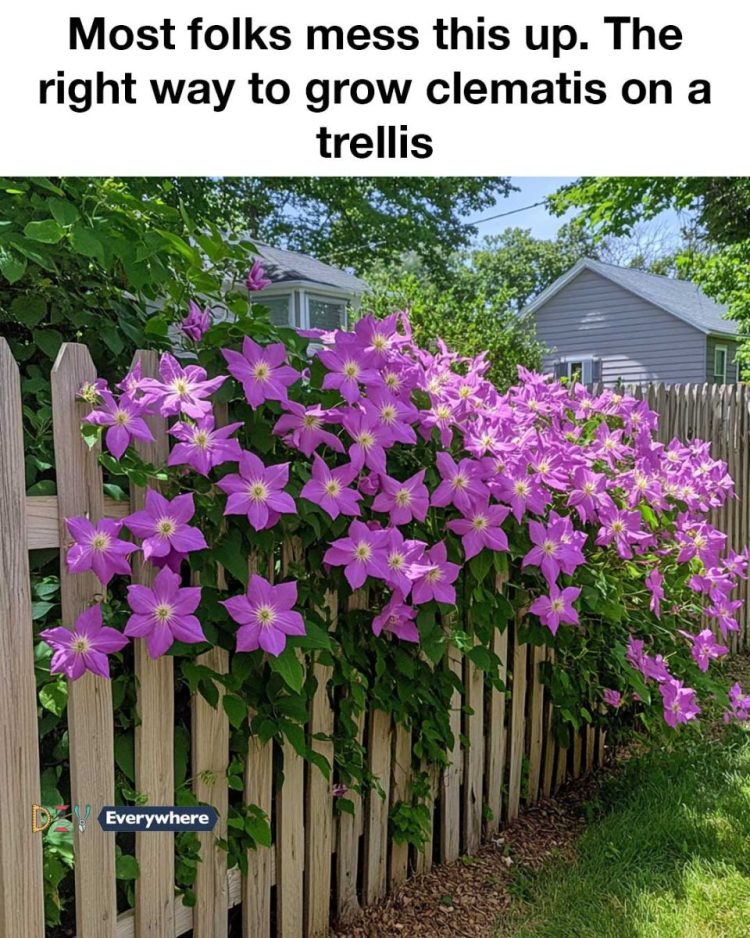Before planting clematis near a wooden picket fence, ensure the fence is sturdy and in good condition. Clematis can become quite heavy when mature, so a strong support is essential. If the fence lacks adequate support for climbing, consider adding a wire mesh or additional trellis panels to provide more climbing surfaces.
Ensure the fence is free from peeling paint or wood treatments that could harm the plant. If necessary, sand and repaint the fence with a plant-safe finish before planting your clematis.
5. Step-by-Step Guide: Planting Clematis Near a Picket Fence
Begin by digging a hole twice as wide and as deep as the clematis’s root ball. Amend the soil with compost to improve drainage and fertility. Position the plant so that the top of the root ball is 2-3 inches below the soil surface, which encourages new shoots to develop from the base.
Backfill the hole with soil and water thoroughly to settle the plant. Mulch around the base with organic material like bark chips or straw to keep the roots cool and moist. Ensure the clematis is planted at least 18 inches away from the fence to allow for air circulation and root expansion.
6. Properly Securing Clematis to the Trellis
As clematis grows, it will naturally twine around the trellis, but it may need some guidance initially. Use soft plant ties or garden twine to gently secure the stems to the trellis, ensuring not to constrict the plant’s growth. Space the ties about 12 inches apart along the stem.
Regularly check the ties as the plant grows, adjusting them as necessary to prevent damage to the stems. Training the plant to grow evenly across the trellis will promote better air circulation and a more attractive display.
7. Watering and Fertilizing for Optimal Growth
Clematis requires consistent moisture, especially during the growing season. Water deeply once or twice a week, ensuring the soil remains evenly moist but not waterlogged. During hot, dry periods, increase watering frequency to prevent stress.
Fertilize clematis in early spring with a balanced, slow-release fertilizer. A second application can be made in mid-summer if the plant appears to need a nutrient boost. Avoid high-nitrogen fertilizers, as they can promote excessive foliage growth at the expense of flowers.
8. Pruning Techniques to Encourage Healthy Blooms
Pruning clematis correctly is essential for maintaining plant health and encouraging blooms. Group 1 clematis should be pruned immediately after flowering, removing only dead or weak stems. Group 2 varieties benefit from light pruning in late winter or early spring, cutting back to a pair of healthy buds.
Group 3 clematis should be pruned hard in late winter, cutting stems back to 12-18 inches above the ground. This encourages vigorous new growth and abundant flowering. Always use clean, sharp pruning tools to prevent disease transmission.
9. Common Mistakes to Avoid When Growing Clematis
One common mistake is planting clematis too deeply or too shallowly, which can hinder growth. Ensure the root ball is 2-3 inches below the soil surface. Over-fertilizing, particularly with high-nitrogen fertilizers, can lead to lush foliage but few flowers.
Another mistake is neglecting to provide adequate support. Clematis needs a sturdy trellis or fence to climb, and without it, the plant may become tangled and prone to disease. Finally, improper pruning can reduce flowering, so be sure to follow the correct techniques for your clematis group.
10. Viral Hacks for Enhancing Clematis Growth
One popular hack is to plant clematis with its roots shaded by a companion plant, such as a low-growing perennial or ground cover. This helps keep the roots cool and moist, promoting healthier growth.
Another tip is to use Epsom salts as a soil amendment. Dissolve 1 tablespoon of Epsom salts in a gallon of water and apply it to the soil around the clematis once a month during the growing season. The magnesium in Epsom salts can enhance flower production and overall plant vigor.
11. Seasonal Care Tips for Year-Round Clematis Beauty
In spring, focus on feeding and training new growth. Apply a balanced fertilizer and guide the stems onto the trellis. As summer approaches, maintain consistent watering and mulch to retain soil moisture.In fall, clean up fallen leaves and debris around the base of the plant to prevent disease. Winter care involves protecting the roots with a layer of mulch and ensuring the trellis remains secure against winter winds. By following these seasonal care tips, your clematis will remain healthy and beautiful year-round.

Most folks mess this up. The right way to grow clematis on a trellis
ADVERTISEMENT
For Complete Cooking STEPS Please Head On Over To Next Page Or Open button (>) and don’t forget to SHARE with your Facebook friends
ADVERTISEMENT